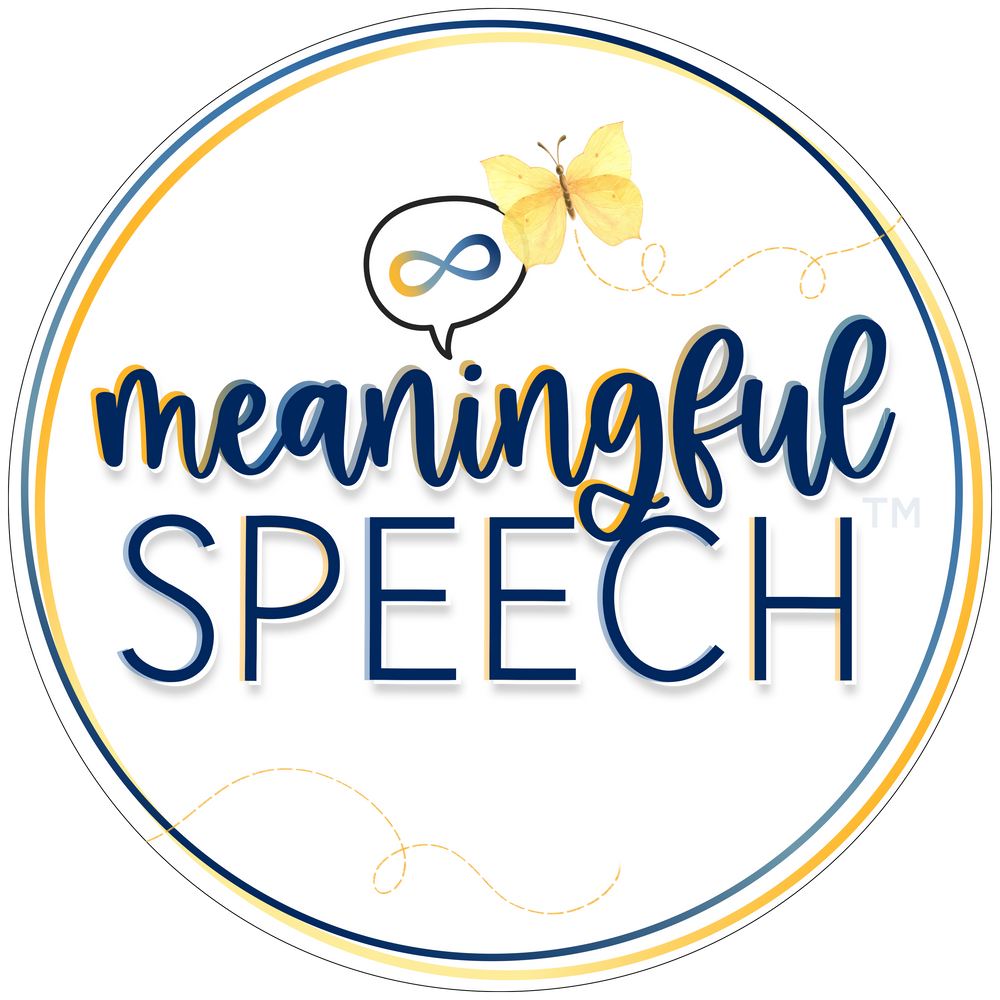Why we say “no” to PECS® as an AAC system & Recommendations for what to do instead
Oct 30, 2024
We often are asked about PECS® as an AAC system. We wanted to be clear about where we stand on PECS® with all children, regardless of how they process language, with information about gestalt language processing as well. We also wanted to give you recommendations for what to do instead.
What is PECS®?
Picture Exchange Communication System (PECS®) is a low-tech AAC system created in 1985 by Andy Bondy, PhD, and Lori Frost, MS, CCC-SLP. It is based on B.F. Skinner’s book, Verbal Behavior, and applied behavior analysis (ABA). PECS® requires the child to give a picture to a communication partner (trainer) in order to receive a concrete outcome (reinforcer). There are 6 phases of the PECS® protocol. This information is available on their website.
Phase 1: Child learns to exchange single pictures for highly desired items.
Phase 2: Child learns to generalize skills in different contexts. They are also taught to be "more persistent" communicators.
Phase 3: Child learns to select from two or more pictures to ask for their favorite things (These are placed in a PECS® Communication Book)
Phase 4: Child learns to construct simple sentences on a detachable sentence strip using an “I want”. This is also when verbs, adjectives and prepositions are added in.
Phase 5: Individuals learn to use PECS® to answer questions.
Phase 6: Individuals are taught to comment in response to questions.
It is often used as a prerequisite
PECS® is often used as a prerequisite to robust AAC. Many professionals require children to use PECS® before they will even trial a more robust system with them. However, there are no prerequisites to more robust systems. None. We want to presume competence for all children and provide them with robust systems to start. Directly from ASHA: "there are no specific prerequisites (e.g., age, cognitive, linguistic, motor) for getting started with AAC. (ASHA, n.d.).
It isn't a robust system
Communication is more than just requesting. Requesting is only a small part of day-to-day interactions. We want to support a variety of communicative intents such as protesting, commenting, asking questions, self-advocating, sharing joy, etc. However, up until phases 5+ of PECS®, it only focuses on requesting and up until phase 4 it only focuses on single word noun picture cards. It does not expand to adjectives, verbs and prepositions until then. Unlike more robust systems that provide access to these from the start.
It is based on compliance
PECS® does not encourage naturalistic modeling of language; rather, it encourages communication partners to withhold highly desired objects and/or food until the targeted behavior of that phase is achieved. There isn't a focus on connection with the learner. Connection and trust are foundational to all language development, regardless of if a child is a gestalt or analytic language processor.
There is no motor planning involved
Unlike more robust, high-tech systems where the buttons are always in the same place, the photo cards that are used in PECS® are not required to be placed back in the same spot. They're often moved around the PECS® book as it's used. Every time a child wants to communicate, they have to search the book for the item they're looking for. This is not only time consuming, but also frustrating. Imagine if every time you needed to send an email, search something on Google, type a comment on Instagram, etc. the letters on the keyboard weren't in the same place?
It is both expensive & complicated
PECS® is both expensive and complicated to implement. In phase 3, the photo cards are added to a PECS® book. These photo cards are continuously purchased or created, laminated, and stuck into a ringed binder with self-adhesive hook fastener strips. This is time consuming. It's also expensive. As photos get added, these books get heavy. Since we want to provide children with access to communicate at all times, these books need to be carried around everywhere. The photos are also easily lost. This means the child does not always have access to the words they need to communicate.
It doesn't support gestalt language development
PECS® is often implemented with gestalt language processors in the early stages (stages 1-2), however, it doesn't support the way they develop language in these stages. Gestalt language processors do not recognize single words as units of meaning in the early stages of gestalt language development. Focusing on single words in these stages will leave GLPs stuck. It often leaves them with a repertoire filled with stuck single word gestalts that cannot be built upon. GLPs in the early stages need more mitigable gestalts to support them through the stages of gestalt language development.
The goal is “survival” language
The goal of PECS® is functional or “survival” language. However, our goal with gestalt language processors is not functional language. Our goal is for GLPs to use self-generated original, flexible language that they have acquired naturally. PECS® is based on a strict protocol that is based on compliance. Language is directly taught with expectation that it be used through the use of withholding and reinforcers. We do not need to teach language to GLPs. Instead, we model language naturally during everyday routines and play without expectation. GLPs pick up language that is meaningful to them just from hearing it.
So what DO we recommend?
We recommend getting children started with robust systems immediately. This means the system includes many different types of vocabulary (core words, fringe vocabulary, access to the alphabet) and allows the child to communicate for a wide variety of reasons (e.g. request, protest, share information, share opinions, ask questions, etc.) We recommend focusing on natural, authentic interactions and modeling these systems without expectation. Focusing on trust and connection, not compliance. If you need to use light tech AAC rather than high tech speech generating systems, we recommend using light tech, robust communication boards or dynamic displays/flip books instead. Most high tech apps (e.g. TouchChat, Proloquo2Go, TobiiDynavox, etc.) have these available free for download on their website. These are all more robust to start than PECS®. If you’re looking for more information on robust AAC systems and gestalt language processing, here’s a helpful blog post.
New Beginner’s Guide to AAC & Gestalt Language Processors
We just released a brand new 45-minute free beginner’s guide to AAC and Gestalt Language Processing!
Taught by SLP & AAC specialist and Meaningful Speech team member, Laura Hayes, who is also the instructor of our AAC for Gestalt Language Processors course. The Beginner’s guide is perfect for anyone wanting to start their journey learning more about how to best support gestalt language processors who currently use or may benefit from AAC.
Enroll for free today and send the link to anyone who may want to start their journey! We would love for this information to be shared far and wide.
Want to learn more in-depth information about how to support gestalt language processors?
- There are many free podcasts, webinars and articles to get you started. A comprehensive list of resources can also be found on our website. We just released a new FREE masterclass on echolalia and child-led therapy and a Beginner's Guide to AAC and Gestalt Language Processing that are both perfect for anyone starting their learning journey or on the fence about purchasing our courses!
- Consider taking the Meaningful Speech course to learn more about how your child or client processes language, how you can help support them from echolalia to self-generated (original flexible) language, child-led therapy, and neurodiversity-affirming practices. Looking for something shorter? We have a 1-hour introductory course perfect for extended family, daycare or school staff.
- Consider taking our AAC + Gestalt Language Processing course. It will teach you how to identify, evaluate and support gestalt language processors who use AAC or who you think might benefit from AAC.
- Look for a speech-language pathologist (SLP) who "gets it" and can help you in supporting your child's language development. Check out our registry for SLPs who understand gestalt language processing and child-led therapy.
- Are you a school-based or private practice clinician looking for intake forms for new clients/students or creative visual reminder posters for your space? Check out the Meaningful Speech Marketplace.
- Want to learn more about starting a niche private practice? Watch our 1-hour webinar on starting a niche private practice hosted by Alex Zachos and Jess Teixeira from the Meaningful Speech team HERE.
